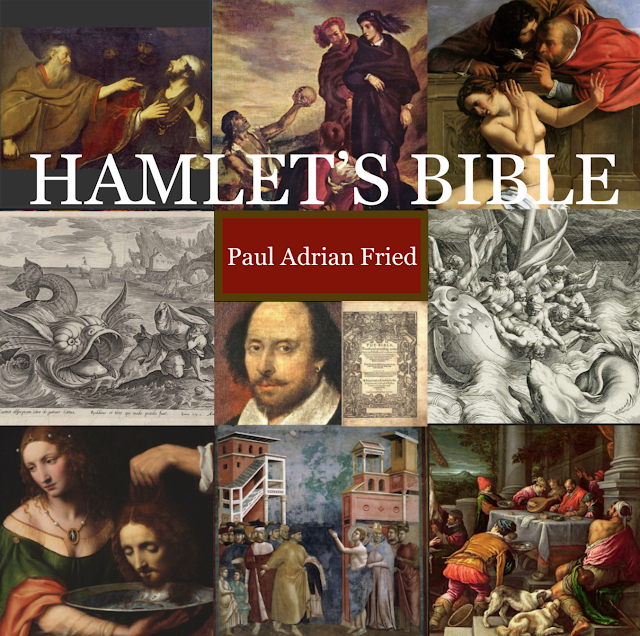Hamlet ≠ Orestes; Gertrude ≠ Hecuba nor Clytemnestra
Hecuba,
Agamemnon and his wife Clytemnestra,
their daughters Iphigenia and Electra,
and their son, Orestes.
I recently posted about Tanya Pollard’s good article on Hecuba and Shakespeare,[1] so this post will focus on Clytemnestra, Iphigenia, and Orestes.
Due to poor winds, Agamemnon was unable to sail to the Trojan war to help his brother, King Menelaus of Sparta, whose wife Helen had been seduced and taken by Paris, prince of Troy. A priest claimed that if Agamemnon sacrificed his daughter Iphigenia, the gods might be appeased and the winds might improve.
One can already tell that this tale will not end well.
Thinking Iphigenia is sacrificed,[2] Clytemnestra is grieved and traumatized. In one version, Agamemnon had killed Clytemnestra’s first husband and taken her as a prize, so this adds to her sense of violation.
Winds change. Agamemnon sails; the Trojan War lasts 10 years.
In his absence, Clytemnestra takes Aegisthus, Agamemnon’s cousin, as a lover.
(This is vaguely similar to Gertrude having an affair with King Hamlet’s brother, Claudius.)
In one version of the tale, when Agamemnon returns, Clytemnestra kills him in his bath after ensnaring him in a net. Aegisthus becomes king, and Clytemnestra remains queen.
Orestes, son of Agamemnon and Clytemnestra, is urged by the Oracle of Delphi and by his sister Electra to avenge their father’s death. With help from his friend Pylades, he kills his mother and Aegisthus.
All of this is helpful to an understanding of Hamlet:
In 2.2.427, Hamlet calls Polonius “Jephthah,” a “judge of Israel” who was, like Agamemnon, willing to sacrifice his daughter on the altar of his ambition. For this reason, Jephthah’s daughter is often compared to Iphigenia.[3]
After The Mousetrap, Hamlet goes to his mother’s closet and says he will “speak daggers to her, but use none.” (3.2.429) In other words, he is determined to scold her for marrying her brother-in-law Claudius, but not to kill her, not to become like Orestes. Although he and Horatio may seem parallel to Orestes and Pylades, Hamlet is not Orestes. [4]
Hamlet is upset that his mother does not mourn more for his father's death, like Hecuba who grieves the death of children and husband, and who seeks revenge (as Tanya Pollard explains). But she is not Hecuba (perhaps reflecting a Protestant aversion to Catholic mourning/purgatory?).
By the end of the closet scene, perhaps Hamlet views himself not as Orestes, but as an Elijah figure, and Gertrude more as the widow in 1 Kings 17, or in 2 Kings 4? Or himself as like the widow’s son in 1 Kings 17, or one of the two debt-enslaved sons in 2 Kings 4?
(A topic for a future post…).
NOTES:
[1] https://pauladrianfried.blogspot.com/2022/11/tanya-pollards-whats-hecuba-to.html
[2] In some versions, Iphigenia is saved from sacrifice by the gods at the last moment, and later meets up with her siblings Electra and Orestes.
[3]All references to Hamlet are to the Folger online version:
https://shakespeare.folger.edu/shakespeares-works/hamlet/entire-play/
[4] See
Hamlet and Orestes: A Study in Traditional Types
by Gilbert Murray (1866-1957).
https://archive.org/details/hamletorestesstu00murr
See also
Hamlet and Orestes
by Jan Kott and Boleslaw Taborski
PMLA
Vol. 82, No. 5 (Oct., 1967), pp. 303-313 (11 pages)
Published By: Cambridge University Press
https://doi.org/10.2307/460759
https://www.jstor.org/stable/460759
IMAGES L-R:
Merry-Joseph Blondel (France, Paris, 1781-1853)
Hecuba and Polyxena (after 1814)
Los Angeles County Museum of Art
Public Domain
https://commons.wikimedia.org/wiki/File:Hecuba_and_Polyxena_LACMA_73.3.jpg
Wall painting - sacrifice of Iphigenia - Pompeii
Napoli, Museo Archeologico Nazionale
Creative Commons
Photo 7 October 2018, 14:45:23 by ArchaiOptix
https://commons.wikimedia.org/wiki/File:Wall_painting_-_sacrifice_of_Iphigenia_-_Pompeii_(VI_8_5)_-_Napoli_MAN_9112_-_01.jpg
(Blood-stained) Clytemnestra (1882) by John Collier (d. 1934).
Guildhall Art Gallery, City of London
Public Domain
https://commons.wikimedia.org/wiki/File:Clytemnestra_by_John_Collier,_1882.jpg
William-Adolphe Bouguereau (1825–1905)
The Remorse of Orestes or Orestes Pursued by the Furies
1862
Chrysler Museum of Art
https://commons.wikimedia.org/wiki/File:Orestes_Pursued_by_the_Furies_by_William-Adolphe_Bouguereau_(1862)_-_Google_Art_Project.jpg
~~~~~~~~~
FOR MORE READING:
Greek Tragic Women on Shakespearean Stages (Oxford, 2017)
by Tanya Pollard
https://global.oup.com/academic/product/greek-tragic-women-on-shakespearean-stages-9780198793113?cc=us&lang=en&
Shakespeare and Classical Tragedy: The Influence of Seneca,
by Robert Miola
https://global.oup.com/academic/product/shakespeare-and-classical-tragedy-9780198112648?cc=us&lang=en&
How the Classics Made Shakespeare
By Jonathan Bate
https://press.princeton.edu/books/hardcover/9780691161600/how-the-classics-made-shakespeare
I'm sure there are excellent sources in languages other than English on the topic of Shakespeare and mythology. If you are aware of them, feel free to post them in comments.
~~~~~~~~~~~~~~~~~~~~~~~~
Disclaimer: If and when I quote or paraphrase bible passages or mention religion in many of my blog posts, I do not intend to promote any religion over another, nor am I attempting to promote religious belief in general; only to explore how the Bible and religion influenced Shakespeare, his plays, and his age.
~~~~~~~~~~~~~~~~~~~~~~~~
~~~~~~~~~~~~~~~~~~~~~~~~~~~~~~~~~~~~~~
Thanks for reading!
~~~~~~~~~~~~~~~~~~~~~~~~~~~~~~~~~~~~~~
~~~~~~~~~~~~~~~~~~~~~~~~~~~~~~~~~~~~~~
My current project is a book tentatively titled Hamlet’s Bible, about biblical allusions and plot echoes in Hamlet.
Below is a link to a list of some of my top posts (“greatest hits”),
including a description of my book project (last item on the list):
https://pauladrianfried.blogspot.com/2019/12/top-20-hamlet-bible-posts.html
I post every week, so please visit as often as you like and consider subscribing.
To find the subscribe button, see the = drop-down menu with three lines in the upper left.


Wonderful scholarship
ReplyDeleteThank you! But I would quickly note that my summary of just a few points in this short (3,000 character) post depend entirely on sources such as those listed here in my notes and "further reading": Miola, Bate, and Pollard, etc. But thank you nonetheless!
Delete